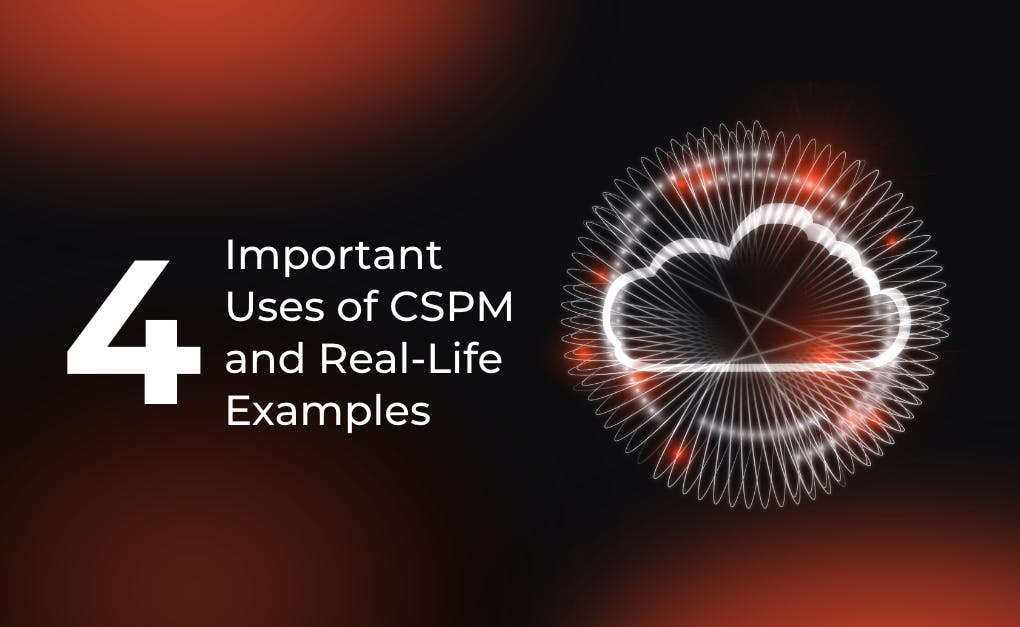Today, cloud computing has become a critical part of many organizations' IT infrastructure, enabling organizations like yours to access and store data remotely and making it more accessible and flexible.
However, the cloud also poses significant security risks that must be addressed to ensure data protection and compliance.
To that end, it’s not difficult to see how and why Cloud Security Posture Management (CSPM) is critical for securing your cloud infrastructure and data.
Let’s look at four important uses of a CSPM and some real-life examples of how organizations have used it to protect their cloud environments.
What is Cloud Security Posture Management?
Before we start, let’s take a look at what Cloud Security Posture Management is.
In simple terms, cloud security posture management continuously monitors and assesses your organization's cloud infrastructure to identify and remediate security risks. It does the abovementioned by
- ensuring that cloud resources are correctly configured and patched,
- monitoring access to cloud resources, and
- ensuring compliance with industry regulations and security best practices.
In short, CSPM tools provide real-time security monitoring, automated security configuration, and continuous security assessments, all of which help your organization to identify and address cloud security risks.
Proactive Risk Management
Cloud security posture management significantly reduces security risks associated with cloud computing by providing continuous, real-time security monitoring, automated remediation, and continuous security assessments, making it easier for you to identify and remediate security risks proactively instead of reactively.
It also helps you prioritize security risks based on the potential impact on your business. This can include identifying critical assets at risk, such as sensitive data or mission-critical applications. With this knowledge, you can first address the most significant risks.
And you don’t have to do that alone.
A CSPM can also provide recommendations on addressing these cloud security risks in the cloud environment.
If a misconfiguration is detected, the tool can provide suggestions for remediating it. This can include changes to security policies or configurations that can help reduce the risk of a security breach.
For example, Capital One, a financial services company, experienced a significant data breach in 2019, exposing over 100 million customers' personal information because of misconfigured cloud resources, which attackers could exploit.
Following the breach, Capital One implemented CSPM tools to ensure that its cloud infrastructure was configured correctly and securely, thereby significantly reducing the risk of future breaches.
Ensuring compliance
An excellent way to safeguard your data is to ensure that you comply with international and industry-specific standards and security best practices.
A CSPM can continuously monitor and detect deviations from regulatory requirements or industry-specific standards.
For example, if you are a merchant or organization that accepts and processes credit card payments, complying with the PCI-DSS standard is essential to safeguarding and protecting credit card transactions.
Moreover, you can use a CSPM to automatically generate reports and alerts when a deviation is detected or generate a compliance report for audit purposes.
Just imagine saving oodles of time with this feature during audits! These features can significantly help you and your organization address compliance issues proactively.
For example, Horangi WardenHorangi Warden is used by many organizations, including Financial Services and Healthcare institutions, to help check and advise them on their compliance efforts with international and regional industry standards such as PCI DSSPCI DSS, MAS TRMMAS TRM, ISO 27001ISO 27001, GDPR, OJK, etc.
In the United States, healthcare organizations are required by Federal law to comply with the Health Insurance Portability and Accountability Act (HIPAA) to protect the privacy and security of patient information. To ensure that their cloud infrastructure complies with HIPAA regulations, AdventHealth, a healthcare provider, utilizes a CSPM to help check, identify, and remediate compliance issues, ensuring that patient data is protected.
Streamline Security Management
A CSPM can help your organization streamline your cloud security management processes. One of the ways that a CSPM tool can help provide you with streamlined security management is by centralizing security management for your cloud infrastructure.
In other words, rather than having to purchase and implement several tools to monitor and manage your cloud security, you can now monitor and control your cloud environments from a single point of access, thereby streamlining the management of cloud security and making it easier for you to identify and resolve any security issues.
Finally and perhaps most importantly, you can use a CSPM to get a unified view of your organization’s cloud security posture. With this single, unified view, you can now see your cloud environments' overall security posture, providing insights into the most critical areas to address. Moreover, the tool also helps prioritize security risks based on the potential impact on your business and provides recommendations on how to address these risks.
These automated security assessments and remediation can help you significantly reduce human error and ensure that you are always up-to-date with and adhering to the latest security requirements.
For example, Autodesk, a software company, was able to improve its security posture and ensure that its cloud infrastructure was configured correctly and secured by utilizing a CSPM.
Among other benefits, the CSPM provided Autodesk with real-time security monitoring and automated remediation, significantly reducing the time and resources required to manage security risks.
Of particular significance is automated remediation, like that available on Horangi Warden, which can also help your organization beat the cybersecurity manpower crunch or the lack of trained cybersecurity specialists.
Better control over your cloud security
Finally, if you haven’t already done so, you should take advantage of a CSPM’s ability to provide you with real-time security monitoring. This will help you make informed decisions and improve your cloud security posture.
Here are a few ways a CSPM helps:
Detect and identify misconfigurations in your cloud environment.
This can include misconfigured security settings, access controls, and network settings. By identifying these misconfigurations, you can fix them before attackers can exploit them.
Prioritize security risks and track the associated remediations.
You can utilize the CSPM to help prioritize the most critical security risks that must be addressed, track the progress of remediation efforts, and ensure that your cloud environment is continuously improving.
Automate security processes in the cloud environment.
A CSPM provides you with automation of security alerts, incident response, and compliance checks. Automating these processes can reduce the time and effort required to maintain secure configurations and compliance in the cloud.
For example, Mizuno Corporation, a global sports equipment and apparel company, implemented a CSPM to streamline its security management processes. By automating security assessments and remediation, Mizuno was able to improve its security posture and reduce the risk of security breaches.
Conclusion: A CSPM is essential
Cloud computing has become an integral part of business operations but also brings security challenges that must be addressed.
In addition to providing you with a centralized view of the security posture of your cloud infrastructure, a Cloud Security Posture Management tool (CSPM) also helps you:
- protect sensitive data,
- automate security processes and maintain secure configurations,
- gain better visibility and control of your cloud environment
- prioritize security risks, and
- ensure compliance with industry and regulatory standards in your cloud environment.
In conclusion, a CSPM is crucial for you and your organization to maintain a proactive approach to managing security risks in the cloud, ultimately reducing the risk of security breaches and maintaining the trust of your customers.
As a result, you can achieve a higher level of security, reduce the risk of security breaches, and protect your organization's reputation and financial well-being.
If you are considering implementing a CSPM to safeguard your investment in the cloud, why not give us a call or fill up this form to set up a call or demo? We’ll get back to you soonest with more details on Horangi Warden.




